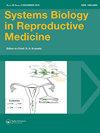DNA甲基转移酶和组蛋白去乙酰化酶抑制剂处理后克隆小鼠胚胎的表观遗传重编程
IF 2.1
4区 医学
Q3 ANDROLOGY
引用次数: 3
摘要
研究了DNA甲基转移酶抑制剂RG108和组蛋白去乙酰化酶抑制剂SAHA对体细胞核转移至卵母细胞的克隆小鼠胚胎重编程参数的影响。研究的编程参数包括组蛋白再乙酰化、发育速率、DNA甲基化和基因转录水平的动态,所有这些都是谱系规范和囊胚形成的关键。在原核阶段,经5µM SAHA处理的体细胞核移植卵母细胞在H3K9、H3K14、H4K16和H4K12位点的组蛋白乙酰化程度高于未处理的克隆(p < 0.05)。在桑葚胚期,5 μM RG108或5 μM SAHA处理的克隆胚胎DNA甲基化强度低于未处理的克隆胚胎(p < 0.05),与受精胚胎的DNA甲基化强度相似。然而,当RG108和SAHA联合使用时,没有观察到这些效果。5µM SAHA处理的克隆胚胎桑葚胚形成率显著高于未处理的克隆胚胎,而RG108处理对桑葚胚形成率无明显影响。另一方面,与未处理的克隆相比,RG108和SAHA联合处理导致克隆桑葚胚形成率较低。在囊胚期,RG108可纠正克隆胚胎中关键发育基因Oct4和Cdx2的异常表达水平,而非Nanog的异常表达。这与在受精胚胎中看到的强度水平相似。RG108和SAHA处理的胚胎中Rpl7l1基因的表达明显高于未处理和对照组。综上所述,本研究表明,SAHA和RG108单独应用可提高克隆小鼠胚胎的率和质量。本文章由计算机程序翻译,如有差异,请以英文原文为准。
Epigenetic reprogramming in cloned mouse embryos following treatment with DNA methyltransferase and histone deacetylase inhibitors
Abstract We examined the effects of DNA methyltransferase inhibitor – RG108, and histone deacetylase inhibitor – SAHA, on the reprogramming parameters of cloned mouse embryos produced by somatic cell nuclear transfer into oocytes. The programming parameters studied included dynamics of histone reacetylation, developmental rate, DNA methylation, and transcript levels of genes, all of which are pivotal to lineage specification and blastocyst formation. At the pronuclear stage, somatic nucleus-transplanted oocytes treated with 5 µM SAHA presented higher histone acetylation at H3K9, H3K14, H4K16 and H4K12, compared to untreated clones (p < 0.05). At the morula stage, cloned embryos treated with 5 μM RG108 or 5 μM SAHA presented lower DNA methylation intensity compared to untreated clones (p < 0.05), resembling the intensity levels of fertilized embryos. However, these effects were not observed when RG108 and SAHA were used in combination. The rate of morula formation was significantly higher in cloned embryos treated with 5 µM SAHA than in untreated clones, whereas treatment with RG108 resulted in no obvious effects on morula formation rates. On the other hand, the combined treatment with RG108 and SAHA resulted in inferior rates of cloned morula formation, compared to untreated clones. At the blastocyst stage, the aberrant expression levels of key developmental genes Oct4 and Cdx2, but not Nanog, were corrected in cloned embryos by the treatment with RG108. This is similar to the intensity levels seen in fertilized embryos. The expression of Rpl7l1 gene was significantly higher in embryos treated with both RG108 and SAHA than in untreated and in control groups. In summary, the present study showed that SAHA and RG108, when applied separately, improve the rate and quality of cloned mouse embryos.
求助全文
通过发布文献求助,成功后即可免费获取论文全文。
去求助
来源期刊
CiteScore
4.30
自引率
4.20%
发文量
27
审稿时长
>12 weeks
期刊介绍:
Systems Biology in Reproductive Medicine, SBiRM, publishes Research Articles, Communications, Applications Notes that include protocols a Clinical Corner that includes case reports, Review Articles and Hypotheses and Letters to the Editor on human and animal reproduction. The journal will highlight the use of systems approaches including genomic, cellular, proteomic, metabolomic, bioinformatic, molecular, and biochemical, to address fundamental questions in reproductive biology, reproductive medicine, and translational research. The journal publishes research involving human and animal gametes, stem cells, developmental biology and toxicology, and clinical care in reproductive medicine. Specific areas of interest to the journal include: male factor infertility and germ cell biology, reproductive technologies (gamete micro-manipulation and cryopreservation, in vitro fertilization/embryo transfer (IVF/ET) and contraception. Research that is directed towards developing new or enhanced technologies for clinical medicine or scientific research in reproduction is of significant interest to the journal.

 求助内容:
求助内容: 应助结果提醒方式:
应助结果提醒方式:


